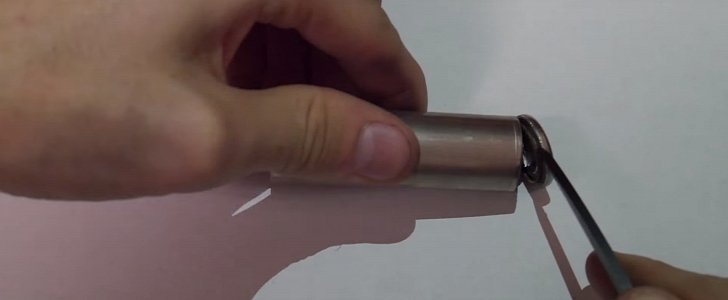There aren't that many videos of people cutting open a battery cell out there, and there's a good reason for it: not everyone is capable of doing it.
"What do you mean? How hard can it be to grab an ax and give it your best swing?" Well, sure, by all means, go right ahead if, for some odd reason, you miss lying in a hospital bed for a pretty long time, just don't tell anyone we told you to.
The thing with battery cells is that they're a very carefully contained microsystem, and if one thing makes contact with another thing that it's not designed to, things - flamy ones - can happen. Which is why it's best to get a degree in physics before you attempt any of it on your own.
We don't know anything about the background of the guy performing this autopsy, but considering he lived to tell the story, we guess it wasn't just luck and he knew what he was doing. After all, he does start the video by mentioning he had depleted the cell before trying anything else.
Also, there are no axes involved. Instead, he uses a sharp knife to cut off the positive terminal in a very controlled manner, which makes sure the insides remain in one piece. Or, you know, in as many pieces as they were in when leaving the Gigafactory.
The 2170 battery cell is the new format used by Tesla on the Model 3, claiming it offers roughly 30 percent more energy capacity than the 18650 standard used for the two previous EVs. The cell is indeed larger overall (the numbers stand for its dimensions in millimeters, so it's 21 by 70 compared to 18 by 65), but that's not the entire story.
Upon exposing the innards, the author of the clip (published on a YouTube channel called ARIES RC) unfolds the jelly roll, revealing it's longer than that of a 18650 cell, but also wider due to the five extra millimeters. That makes the 30 percent increase claim entirely plausible.
It also makes Tesla's decision not to use the new cell on the Models S and X as well a bit hard to understand as well, but it actually makes sense. Tesla designed the two larger models with one cell in mind, and changing the entire battery pack would imply too many adjustments both in design and the manufacturing process as well. Plus, the company is struggling to meet Model 3 demand as it is, putting an additional strain on the cell production would definitely not help.
The thing with battery cells is that they're a very carefully contained microsystem, and if one thing makes contact with another thing that it's not designed to, things - flamy ones - can happen. Which is why it's best to get a degree in physics before you attempt any of it on your own.
We don't know anything about the background of the guy performing this autopsy, but considering he lived to tell the story, we guess it wasn't just luck and he knew what he was doing. After all, he does start the video by mentioning he had depleted the cell before trying anything else.
Also, there are no axes involved. Instead, he uses a sharp knife to cut off the positive terminal in a very controlled manner, which makes sure the insides remain in one piece. Or, you know, in as many pieces as they were in when leaving the Gigafactory.
The 2170 battery cell is the new format used by Tesla on the Model 3, claiming it offers roughly 30 percent more energy capacity than the 18650 standard used for the two previous EVs. The cell is indeed larger overall (the numbers stand for its dimensions in millimeters, so it's 21 by 70 compared to 18 by 65), but that's not the entire story.
Upon exposing the innards, the author of the clip (published on a YouTube channel called ARIES RC) unfolds the jelly roll, revealing it's longer than that of a 18650 cell, but also wider due to the five extra millimeters. That makes the 30 percent increase claim entirely plausible.
It also makes Tesla's decision not to use the new cell on the Models S and X as well a bit hard to understand as well, but it actually makes sense. Tesla designed the two larger models with one cell in mind, and changing the entire battery pack would imply too many adjustments both in design and the manufacturing process as well. Plus, the company is struggling to meet Model 3 demand as it is, putting an additional strain on the cell production would definitely not help.


